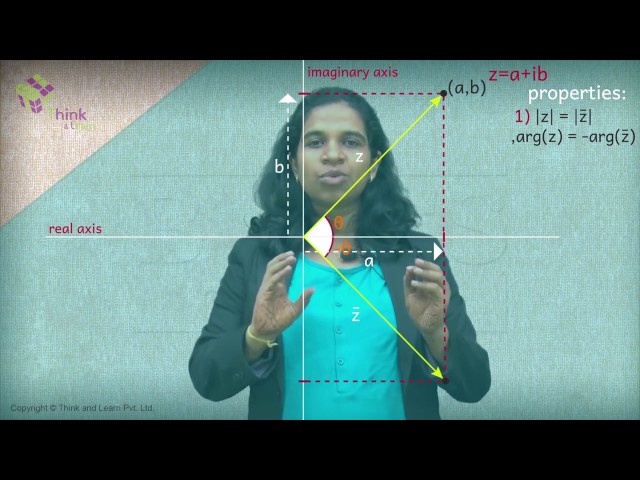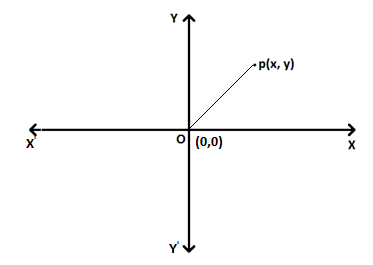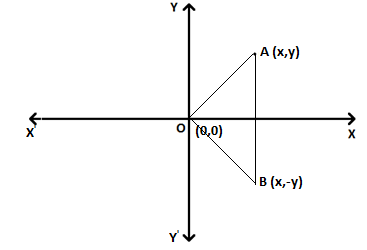Operations on Complex Number
Conjugate of Complex numbers

Modulus of Complex Number
Let \(z\)
Geometrically, modulus of a complex number \(z\)

In the above figure, \(OP\)
Therefore,
\(|z|\)
Example: Find the value of b if the modulus of the complex number, \(z\)
\(|z|\)
\(\sqrt{3^2~+~b^2}\)
\(9~+~b^2\)
\(b^2\)
\(b\)
Therefore, \(z\)
From the above example, we can conclude that complex numbers \(z_1\)
\(z_3\)
Conjugate of a complex number
Conjugate of a complex number \(z\)
For example, conjugate of the complex number \(z\)
- Consider the complex number \(z\)
= \(a~+~ib\) , - \(z ~+~ \overline{z}\)
= \(a ~+ ~ib~+ ~(a~ – ~ib)\) = \(2a\) which is a complex number having imaginary part as zero. - \(Re(z ~+~ \overline{z})\)
= \(2a\) , \(Im(z ~+ ~\overline{z}) \) = \(0\) - \(z ~-~ \overline{z}\)
= \(a~ +~ ib~ – ~(a~ -~ ib)\) = \(2bi\) - \(Re(z~ -~ \overline{z})\)
= \(0\) , \(Im(z~ -~ \overline{z})\) = \(2b\) - Geometrically, reflection of the complex number \(z\)
= \(x~+~iy\) in \(X\) axis is the coordinates of \(\overline{z}.\)

- Modulus of the complex number and its conjugate will be equal.
- Multiplicative inverse of the non-zero complex number \(z\)
= \(a~+~ib\) is
\(z^{-1}\)
Since,\(a~-~ib\)
\(z^{-1}\)
\(z\overline{z}\)
Example: Find the multiplicative inverse of \(z\)
\(z^{-1}\)
\(\overline{z} = 6 – 8i\)
= \(\sqrt{100}\)
\(z^{-1}\)
For any two complex number \(z_1\)
- \(|z_1 z_2|\)
= \(|z_1 ||z_2 |\)
Let \(z_1\)
\(|z_1|\)
\(|z_2|\)
\(z_1 z_2\)
\(|z_1 z_2|\)
\(|z_1 z_2|^2\)
\(=\)
\(=\)
\(=\)
\(=\)
From (1) and (2),
\(|z_1|^2 |z_2 |^2\)
Since, (3) = (4);\(|z_1 z_2|\)
- Similarly \(z_1\)
and \(z_2\) , \(|\frac{z_1}{z_2}|\) = \(\frac{|z_1 |}{|z_2 |}\) , provided that \(z_2\) is a non zero complex number. - \(\overline{z_1z_2}\)
= \(\overline{z_1}\overline{z_2}\) - \(\overline{z_1~ \pm ~z_2}\)
= \(\overline{z_1}~\pm~\overline{z_2}\) - \(\overline{\left(\frac{z_1}{z_2}\right)}\)
= \(\frac{\overline{z_1}}{\overline{z_2}}\) ,provided that \(z_2\) is a non-zero complex number.
Identities of complex numbers
For any two complex numbers \(z_1\)
- \((z_1~+~z_2)^2\)
= \(z_1^2~+~z_2^2~+~2z_1 z_2\)
We can prove the above identity using the properties of complex numbers.
\((z_1~+~z_2)^2\)
By using distributive law,
\((z_1~+~z_2)(z_1~+~z_2)\)
= \(z_1^2~+z_1 z_2~+z_2 z_1~+~z_2^2\)
By using the commutative law, \(z_1 z_2\)
Then (1) will become as,
- \((z_1~+~z_2)^2\)
= \(z_1^2~+~z_2^2~+~2z_1 z_2\) - \((z_1~-~z_2)^2\)
= \(z_1^2~+~z_2^2~-~2z_1 z_2\) - \((z_1~+~z_2)^3\)
= \(z_1^3~+~3z_1^2 z_2~+~3z_1 z_2^2~+~z_1^3\) - \((z_1~-~z_2)^3\)
= \(z_1^3~-~3z_1^2 z_2~+~3z_1 z_2^2~-~z_1^3\) - \(z_1^2~-~z_2^2\)
= \((z_1~+~z_2)(z_1~-~z_2)\) <
To know more about the complex numbers and its properties, download BYJU’S – The learning app.
‘